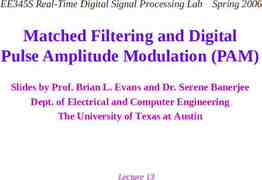Forensic Anthropology: Studying Bones What types of information can we
38 Slides6.77 MB
Forensic Anthropology: Studying Bones What types of information can we gather from studying bones as evidence?
Forensic Anthropology The use of knowledge of the skeletal system to identify crime victims and determine cause and circumstance of death.
Is it human or animal? The study of bones is called osteology. Humans and animals have different skeletal structures, different bones and differently shaped bones. Microscopically, bones contain holes, or osteons, that carry blood. Animal osteons form a regular pattern, while those in humans do not.
The Skeleton An adult human has 206 bones! The skeleton provides structure and protection. Muscles are connected to bone by tendons; bones are connected to each other and joints by ligaments. Bones are classified into four groups: long—arms, legs, hands, feet long short—wrist, ankle short flat—skull, scapula, sternum, hip, ribs flat irregular—vertebrae, skull irregular
A Caveat Informative features about the age, sex, race and stature of individuals based on bones is based on biological differences between sexes and races (males are generally taller and more robust) as well as differences due to ancestry (certain skeletal features of the skull) Imprecise – Due to variation Nevertheless, differences do exist and the more features you survey, the more precise your conclusions will be
What Can We Learn? Determination of Sex – Pelvis – Skull – (Long Bones) Determination of Race – Skull Approximate Age – Growth of long bones Approximate Stature – Length of long bones Postmortem or antemortem injuries Postmortem interval (time of death) http://en.wikipedia.org/wiki/Forensic anthropology
Skull Humerus The bones we’re interested in Pelvis Femur Tibia
Directional Vocabulary Anterior – Front of a person Posterior – rear of the person Caudal – towards the feet of a person Cranial – towards the head of a person Deep – further from the surface Distal – part of the limb furthest from the body Dorsal – along the back Frontal plane – body plane that divides the person into dorsal and ventral parts Lateral – side of a person Mid-Sagittal – body plane that divides the person into “equal” right and left halves Proximal – part of the limb closest to the body Superficial – closer to the surface Transverse – body plane that divides the body into cranial and caudal parts Ventral – along the belly surface
Determination of Sex: Pelvis Pelvis (differences due to adaptations to childbirth) 1. females have wider subpubic angle ( 90 ) 2. females have a broad pelvic inlet 2. 1. 2. 1.
Determination of Sex 3. females have a broad, shovel-like ilium 4. females have a flexible pubic symphysis 5. females have a wider sciatic notch 4. 3. 3. 5. 5.
Sex Determination - Pelvis Sub-Pubic Angle Pubis Body Width Greater Sciatic Notch Pelvic Cavity Shape http://mywebpages.comcast.net/wnor/pelvis.htm
Male vs. female pelvis
Determination of Sex: Cranium Crests and ridges more pronounced in males (A, B, C) Chin significantly more square in males (E) Mastoid process wide and robust in males Forehead slopes more in males (F)
Sex Determination - Skull Trait Female Upper Edge of Eye Orbit Male Sharp Blunt Round Square Zygomatic Process (“cheekbone”) Not expressed beyond external auditory meatus (ear-hole in skull) Expressed beyond external auditory meatus Nuchal Crest (Occipital Bone) Smooth Rough and bumpy External Occipital Protuberance Generally Absent Generally present Frontal Bone Round, globular Low, slanting Mandible shape Rounded, V-shaped Square, U-shaped Ramus of mandible (back of jaw) Slanting Straight Shape of Eye Orbit
Analyze these two skulls. Determine the gender of each using your notes. Write a thorough explanation of your findings. A B
Determination of Sex: Long Bones Normally, the long bones alone are not used alone to estimate gender. However, if these bones are the only ones present, there are characteristics that can be used for sex determination. E.g. maximum length of humerus in females is 305.9 mm, while it is 339.0 mm in males
Determination of Race Difficulties – 3 race system is broad: Caucasian (European), Mongoloid (Asian), and African (African and West Indian). – Some will have traits completely inconsistent with their geographic origin. – Mixed-racial ancestry Some exhibit characteristics of more than one racial group. – Indicators are not measurable and are therefore subjective. Despite these drawbacks, race determination is viewed as a critical part of the overall identification of an individual's remains.
Caucasian, Mongoloid, African From: Beyers, S.N. (2005). Introduction to Forensic Anthropology
Features of the Skull Used in Race Determination Nasal index: The ratio of the width to the height of the nose, multiplied by 100 Nasal Spine Feel the base of the nasal cavity, on either side of the nasal spine – you will feel sharp ridges (nasal silling), rounded ridges, or no ridges at all (nasal guttering) Prognathism: extent of lower jaw Shape of eye orbits (round or square Nasal spine
Nasal Silling and Guttering From: Beyers, S.N. (2005). Introduction to Forensic Anthropology
General Shapes of the Eye Orbits From: Beyers, S.N. (2005). Introduction to Forensic Anthropology
Determination of Race: Caucasian Trait Orbital openings: round Nasal Index: 48 Nasal Spine: Prominent spine Nasal Silling / Guttering: Sharp ridge (silling) Prognathism: Straight Shape of Orbital Openings: Rounded, somewhat square Nasal spine: Prominent Progathism: straight http://upload.wikimedia.org/wikipedia/en/c/cc/Skullcauc.gif
Determination of Race: Mongoloid (Asian decent and Native American decent) Trait Nasal Index Nasal Spine 48-53 Somewhat prominent spine Nasal Silling/ Guttering Rounded ridge Prognathism Variable Shape of Orbital Openings Rounded, somewhat circular http://upload.wikimedia.org/wikipedia/en/b/b3/Skullmong.gif
Determination of Race: African: (everyone of African decent and West Indian decent) Trait Nasal Index 53 Nasal Spine Very small spine Nasal Silling/ Guttering No ridge (guttering) Prognathism Prognathic Shape of Orbital Openings Rectangular or square http://upload.wikimedia.org/wikipedia/en/5/5e/Skullneg.gif
Determination of Age The long bones are those that grow primarily by elongation at an epiphysis at one end of the growing bone. The long bones include the femurs, tibias, and fibulas of the legs, the humeri, radii, and ulnas of the arms, and the phalanges of the fingers and toes. As a child grows the epiphyses become calcified (turn to hard bone)
Determination of Age from Bones Ages 0-5: teeth are best – forensic odontology – Baby teeth are lost and adult teeth erupt in predictable patterns Ages 6-25: epiphyseal fusion – fusion of bone ends to bone shaft – epiphyseal fusion varies with sex and is typically complete by age 25 Ages 25-40: very hard Ages 40 : basically wear and tear on bones – periodontal disease, arthritis, breakdown of pelvis, etc. Can also use ossification of bones such as those found in the cranium
Epiphyseal Fusion: A General Guide
Epiphyseal Fusion The figures below are of the Epiphyses of the femur or thigh bone (the ball end of the joint, joined by a layer of cartilage). The lines in the illustrated Image 1 show the lines or layers of cartilage between the bone and the epiphyses. The lines are very clear on the bone when a person, either male or female is not out of puberty. In Image 2, you see no visible lines. This person is out of puberty. The epiphyses have fully joined when a person reaches adulthood, closing off the ability to grow taller or in the case of the arms, to grow longer. Figure 1. Figure 2.
Determination of Age from Bone: Signs of wearing and antemortem injury Occupational stress wears bones at joints Surgeries or healed wounds aid in identification http://library.med.utah.edu/kw/osteo/forensics/pos id/boneid th.html
2. Age Determination: Use of Teeth http://images.main.uab.edu/healthsys/ei 0017.gif http://www.forensicdentistryonline.org/Forensic pages 1/images/Lakars 5yo.jpg
Determination of Stature Long bone length (femur, tibia, humerus) is proportional to height There are tables that forensic anthropologists use (but these also depend to some extent on race) Since this is inexact, there are ‘confidence intervals’ assigned to each calculation. For example, imagine from a skull and pelvis you determined the individual was an adult Caucasian, the height would be determined by: Humerus length 30.8 cm Height 2.89 (lenth of humerus) 78.10 cm 2.89 (30.8) 78.10 cm 167 cm (5’6”) 4.57 cm
Other Information We Can Get From Bones: Evidence of trauma (here GSW to the head) Evidence of post mortem trauma (here the head of the femur was chewed off by a carnivore) http://library.med.utah.edu/kw/osteo/forensics/index.html
Sources: A good website with photos and information on forensic anthropology (including ancestry, sex and bullet holes): – http://www.nlm.nih.gov/visibleproofs/education/ anthropological/ A good site with a range of resources: – http://www.forensicanthro.com/ Another good primer for determining informtion from bones: – http://www.nifs.com.au/FactFiles/bones/how.asp? page how&title Forensic%20Anthropology Great, interactive site: – http://whyfiles.org/192forensic anthro/











































